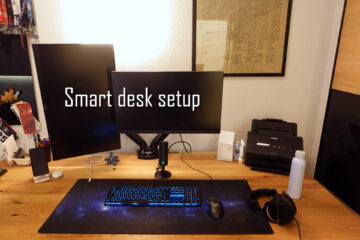Automating a living wall of dozens of plants – stop wasting time
Living wall, green wall, vertical garden – some plants on your wall are great! What makes it even better is that you can mostly automate the process of caring for these plants. Here is how I mounted my living wall frame, how I added plants and how I added automated lights and water supply.
Mounting the frame
In a recent article I described how I built a frame for my living wall project. Once it is ready the next step is mounting it to the wall in its intended place. I had pre-drilled a couple holes through the backplate for mounting purposes. Three at the top and two more at the bottom.

Next I started drilling corresponding holes into the wall after checking for wires in those spots before. As you can see in the picture I had to redo the center one because there was some small piece in the wall that I could not drill through. You can also see my waveform lamp in the image.
To avoid any mold or water damage I also prepared some spacers that will sit between the frame and the wall. They allow fresh air to circle behind the whole construction and has the added benefit of balancing out some slight deformations in the wall.

I had bought some big 8mm screws and corresponding wall plugs really secure this potentially very heavy project. After lifting it into place I screwed everything into the wall and covered the holes with the water resistant foil. I used some hot glue to secure it to the edges of the frame in way that it can removed again later if ever needed.

The whole thing is now very securely mounted and can even hold my full weight. I also made sure to level everything so that the water in the reservoir will not gather on one side later on. At the bottom I made sure to overlap the foil with the reservoir and tested the construction by pouring some water onto the top row of the felt pockets. It all went back down into the reservoir.

Adding some life to the vertical garden
The next step was a bit more time intensive than I had expected: adding the green to the living wall. I went and bought 36 small plants (in several runs) and started planting them into the felt pockets. I tried to go for a nice mix of different plants, from fern to a coffee plant to a very small palm tree. Time will tell if they work well together (looking for similar water usage). For now I only had to replace one of them.

The planting process is simple but takes some time: I put some potting soil into one pocket, opened a small space and put the flower in. Make sure to water everything slightly before and afterwards. Then repeat 35 times 😉 I also tried to slightly angle the plants towards the front as each pocket is also slightly tilted.

I also recommend to spend some time on positioning each plant. I tried to alternate smaller and bigger ones and spread out the same plants over the full area to get some nice mix. You might also have to consider how much water each plants needs but more on that later.
Automating the watering process
Adding all those plants took quite some time so I was glad to build a timesaver for the future. To keep the green wall alive you need to very regularly water the plants. The felt and the loose earth to not store much water. To avoid all this work and to make it self sustainable (at least for a couple of days) I went into automation mode. My first idea was to use a smart relay and some old PC watercooling gear but I found a pre-made solution for just this problem.
If you are looking to build something similar, here are the components I used. Consider buying them via these affiliates link to support the blog!
– automatic pump
– felt pockets
– flexible tubes
– automatic plant lights
– dripper
– holders for the tubes
– plugs for the end of the tube
A local German manufacturer called Gardena is selling water pump systems designed to keep plants on a balcony alive. I decided to skip the work of building a DIY system for once and bought the pump and some accessories for my living wall.


Water reaches the plants through small flexible 4,6mm tubes that are connected to drippers which slowly drip water droplets onto the soil. The tubes can be cut anywhere and you simply have to press them onto the connections at the drippers. Pretty neat. I also bought a set of small holders that grip the tubes and can then be stabbed into the earth to fix them in place.

The tubes run to one side of the frame and then down to the pump. The pump can be connected to up to three runs of tube which works great for me as I decided to only water every second row. This saves on material and makes it all look a bit cleaner. The idea is to push through enough water so that some of it drips down to the row(s) below. This system seems to be working very well for now although I still have to keep an eye on all the plants and manually add some water until they get bigger.

I am still experimenting with right amount of water, right now I am running the pump for 3 minutes every second day. Shorter runs do not put out enough water for it to reach the second row, longer ones seems to produce too much water for now. That might change in the future though. Automating this is very simple with the power adapter of the pump. It has a dial to select a number of minutes per timeframe to run the pump. Everything between 6 minutes every 4 hours and 6 minutes every 72 hours is possible.

This solution is not as smart as some of my other projects, and definitely not connected to any app. In this case I think that is an advantage though. It is very easy to use with few components that could fail, making it great for setting up once and then just keeping it running. The water reservoir can hold dozens of liters of water so I only have to add some from time to time.
Let there be light
Beside water there is a second resource the plants need: daylight. While some light reaches the living wall, it is two to three meters away from the next window and does not have a lot of direct sunshine. I expect this to not be enough light for all of the plants to grow quickly enough so I decided to use an artificial sun here: LED lights. You can buy LED strips made for plants that emit exactly the right wavelengths of blue and red light to mimic the sun.
While I have plans to build a custom wooden fixture for these LEDs in the future (to match the frame) I wanted to get this project to work NOW. So I bought some clamp lamp with flexible arms and mounted it on top of the frame. The different arms can be used to direct the light onto all the plants.

The lamp has a small controller included that can be used to set the color of light (red, blue or both) and a timer. I am currently using both lights 12 hours a day to give the plants lots of power to start growing. This is also a very simple automation without any connectivity but also with few components that could fail. My only annoyance with this solution is that the lights forget all the settings whenever they lose power. That does not happen very often but it is still annoying.
The final living green wall
I am very happy with the final result! The frame adds a lot of color to the room, looks great and the air feels a bit cleaner. I also love how easy it has been to care for. Sure, for the first time I have to keep an eye on all the plants but in general all I need to do is add some water to the tank from time to time. In the future I will have to add fertilizer and maybe trim the plants from time to time.




For me this is one of my best projects yet and I hope I will keep it for a long time. I am still working on some minor changes: adding a proper fixture for the lights and 3D printing some holders for the three tubes.
Sure this project takes some time and a bit of money but only very basic tools. I definitely recommend everybody who is missing shelf space for plants to built something like this!

PS I have done some updates on this and also built a second, smaller, version! Check it out here.


